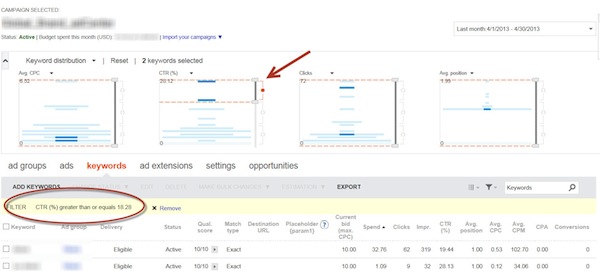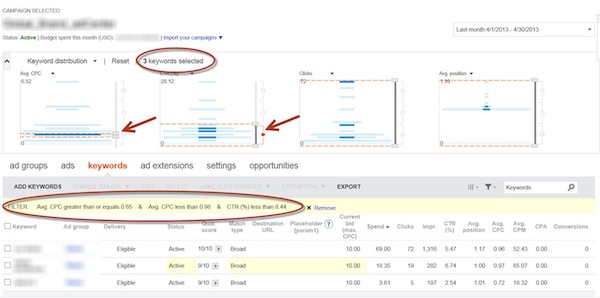Late last month, Bing Ads released a preview of their new Keyword Distribution Graph. Keyword Distribution Graph is revolutionary in many ways, taking data filtering and slicing to a new and visual level.
I’ve been using the tool for a couple of weeks, and am quite impressed. Here’s a preview of the features the tool offers.
Bing Ads Keyword Distribution Graph: What to Expect
Once you have the Graph enabled in your account, select a campaign, and then select the Keywords view. There you’ll find the Graph in a drop-down along with the performance graphs normally found on the keywords page of Bing Ads.

The default view offers a visual representation of where the keywords in your campaign fall in terms of average CPC, CTR, clicks, and average position. If you’d like to see metrics other than these four, you can do that by selecting from the drop-downs above each graph.

In this example, I’ve clicked the drop-down next to Avg. Position, where I can choose Impressions, Spend, Conversions, and CPA.
What I like here is that you can graph four different metrics at once and see how keywords are distributed across your campaigns. Keyword Distribution Graph isn’t a “results over time” tool – it’s a “where does everything fall in the hierarchy” tool, which sets it apart from Google AdWords. Also, Google only shows two metrics in their performance graphs.
The default view is interesting, but let’s say you’d like to drill into the metrics a bit. Keyword Distribution Graph makes it easy to create custom filters for data sets with a few clicks.
You’ll notice that each of the graphs has brackets along the right vertical axis. To narrow down the data to a single bracket are, just click on it.

With a single click, the Graph automatically creates a filter for the keywords that fall into that range! This is a fast and easy way to view your best and worst performing keywords, without manually having to enter formulas into a filter. Better still, because you can see where your keywords fall, you’ll avoid the misstep of creating a filter that returns no results.
In this example, if you wanted to see keywords with a CTR higher than 30 percent, you’d get an empty result – you can already see from the Graphs that the highest CTR keyword is at 28 percent, so filtering for metrics above 28 percent CTR won’t return any results. Keyword Distribution Graph takes the guesswork out of filtering data.
Let’s take the drill-down one step further by clicking on a single line in one of the graphs. This creates a filter for just the keywords that meet that criterion.

As you can see, there is only one keyword that falls into that bucket. While a data set of one may not be very actionable, what I like about this view is that you can see where that keyword falls in terms of all the other graphed metrics: CPC, CTR, and average position. Of course, that data is available in the numbers in the table below, too, but it’s nice to have a graphical view as well.
Now let’s get really crazy and create custom filter combinations. Keyword Distribution Graph makes it easy to do this with just a few clicks. Below, I’ve selected a single line on the Avg. CPC graph, and a bracket on the CTR graph.

Not only does the filtered data appear below the graphs, but Graph tells you how many keywords meet all the criteria.
In the past, it’s always been somewhat challenging to set up filters based on multiple metrics, such as a combination of average CPC and CTR. The visual in Keyword Graph not only requires fewer clicks, but it’s more intuitive than thinking up number parameters like “CTR <1% and average CPC of <$1.”
The only pitfall I’ve found in Keyword Distribution Graph so far is there doesn’t seem to be a way to save these filters for future use. That’s unfortunate. It would be great to not only save the filter, but to set up an automated report that could be emailed on a set frequency (daily, weekly, monthly, etc.). Here is where Google outshines Bing, as Google has had saved filters and reporting for years now.
How PPC Marketers Can Use Graph to Optimize Campaigns
It’s always fun to play with new toys, and the Keyword Distribution Graph is no exception. How can PPC marketers use Graph to optimize campaigns?
- Identify low or high performing keywords in large accounts. If you have hundreds or thousands of keywords in a campaign, it can be challenging to try to quickly find the best and worst keywords. The visuals in Graph make it easy to locate these terms with a couple of clicks.
- Hone in on problem areas quickly. If you see a long line in one of the graphs, that indicates a lot of keywords in that particular bucket. And if the line isn’t up to par with your KPIs, it’s easy to spot and optimize the offenders.
- Obtain subtotals by segments quickly. With a few clicks, you can not only identify your best and worst performing keywords, but also get subtotal data that you can download and manipulate. Sometimes it’s nice to see that you’re actually spending 80 percent of your budget on the best 20 percent of keywords.
- The visual interface means less mental calculation for complex filters. Let’s face it – not all of us think in terms of “x=y.” For those of us who like pictures and graphs, Keyword Distribution Graph is a godsend.
- Export data for further analysis and uploads. Often, you need to do more than just look at data – you need to make adjustments fast. Because Graph creates filters so quickly, it’s simple to export the filtered data, massage it, study it, and upload changes back to the Bing Ads interface.
Bing Ads is currently accepting signups to participate in the beta, so if you’d like to check it out for yourself, go apply.
Have you tried Bing Ads Keyword Distribution Graph? What do you think? What’s your favorite way to use it? What can be improved? Share in the comments!




